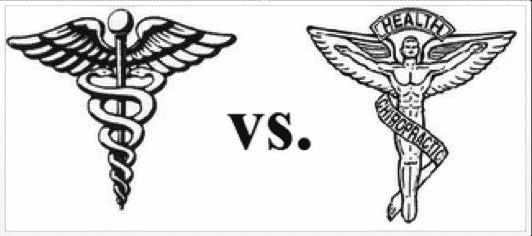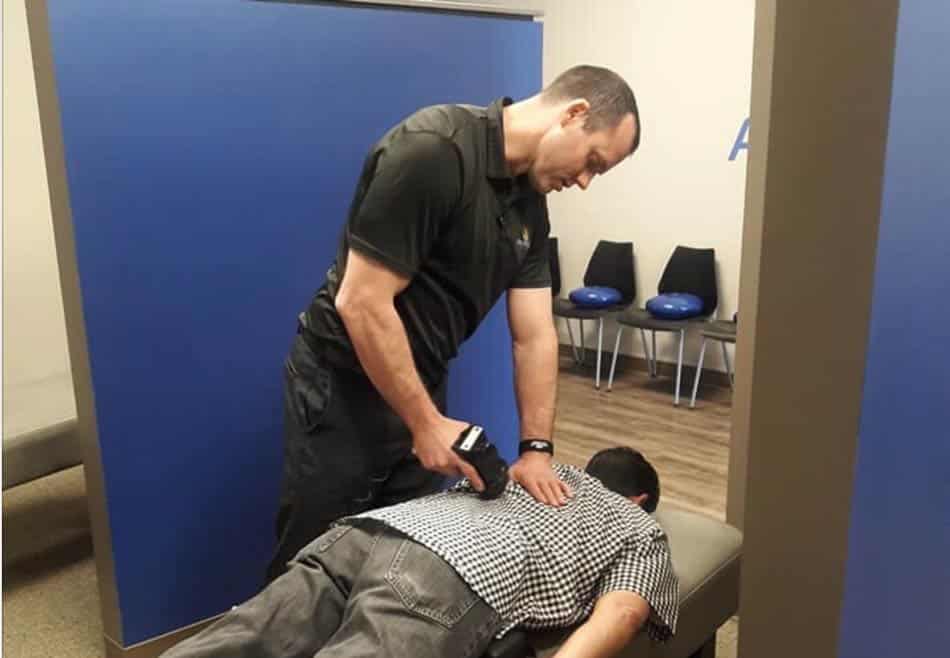WHY DID THE CHIROPRACTIC PROFESSION SUE THE AMA?
In 1987, United States District Judge Susan Getzendanner found the American Medical Association (AMA) and its codefendants guilty of violating the Sherman Antitrust Act (A. Wilk et al. v. AMA et al.). Since Chiropractic services was born into existence in 1895 by its founder D.D. Palmer it has been up against a radical tyrant called the AMA. The AMA had it in their plans to contain (takeover) and eliminate Chiropractic Profession. Why? Because they considered Chiropractic to be competition. So, we sued them and we won!
“Despite Generations of organized medical opposition, Chiropractors did what most other groups of professionals failed to do: they maintained a separate and distinct identity from the practice of medicine while growing in an otherwise hostile environment created by the AMA and its component state assoaciations.”
Chiropractic Care: Principles and Practices
Chiropractic medical care embodies a distinctive set of principles and practices that set it apart from traditional medicine, and understanding these core aspects is pivotal when examining the lawsuit that transformed the chiropractic profession.
Core Principles of Chiropractic Care
- Subluxation Theory and Spinal Adjustments: At the heart of chiropractic care lies the subluxation theory. Chiropractors believe that misalignments in the spine, known as subluxations, can interfere with the body’s innate ability to heal itself. Through spinal adjustments, chiropractors aim to correct these misalignments, facilitating optimal nerve function and overall wellness.
- Holistic Approach to Health and Wellness: Chiropractic care takes a holistic perspective on health, emphasizing the interconnectedness of the body’s systems. Rather than merely addressing symptoms, chiropractors focus on identifying and treating the root causes of health issues, promoting wellness from within.
Types of Conditions Treated by Chiropractors
- Common Musculoskeletal Issues: Chiropractors are renowned for their expertise in addressing musculoskeletal problems, such as back pain, neck pain, and joint discomfort. They employ non-invasive techniques like spinal adjustments, massage, and therapeutic exercises to alleviate pain and improve mobility.
- Expanding Scope of Chiropractic Care: Over the years, chiropractic care has evolved to encompass a broader spectrum of health concerns. Chiropractors may now offer guidance on nutrition, lifestyle modifications, and stress management to enhance their patients’ overall well-being. This expansion in scope reflects chiropractic’s commitment to providing comprehensive care.
As we explore the lawsuit that transformed the chiropractic profession, it becomes evident that these fundamental principles and practices played a pivotal role in shaping chiropractors’ stance and their battle against the medical establishment.
Areas of Contention
In the ongoing debate between chiropractic care and the American Medical Association (AMA), several key areas of contention have emerged, shedding light on the fundamental differences in their approaches to healthcare.
Evidence-Based Medicine vs. Chiropractic Philosophy
- Scientific Research and Chiropractic Efficacy: The divide between evidence-based medicine and chiropractic philosophy often centers on scientific research. Medical physicians, backed by medical specialty societies, emphasize the importance of rigorous scientific studies to validate treatment efficacy. Chiropractors, on the other hand, draw from their holistic philosophy and clinical experience to guide their practice, sometimes relying less on traditional clinical trials.
- Differing Approaches to Healthcare: The contrast in healthcare approaches is stark. Medical physicians typically adhere to standardized protocols based on scientific evidence, while chiropractors prioritize individualized, holistic care that often includes spinal adjustments and lifestyle recommendations. This philosophical gap has fueled much of the tension between the two professions.
Licensing and Regulation
- Chiropractic Licensure Requirements: Chiropractic care operates under distinct licensure requirements compared to traditional medical professions. Chiropractors undergo specialized education and training, focusing on spinal manipulation and holistic healthcare related to Chiropractic. The requirements for chiropractic licensure differ significantly from those of medical physicians, which has been a point of contention.
- AMA’s Advocacy for Standardized Medical Education: The AMA, along with medical specialty societies, has historically advocated for standardized medical education and strict regulation of healthcare professions. This stance has raised concerns among chiropractors who argue for the recognition of their unique training and practice, often in opposition to standardized medical approaches.
As we reflect on the lawsuit that transformed the chiropractic profession and explore the ongoing debates, these areas of contention continue to shape the relationship between medical physicians and chiropractors, influencing the future of both professions.
Perspective of The American Medical Association
Understanding the American Medical Association’s (AMA) perspective on chiropractic care provides valuable insights into the historical opposition and contemporary views that have shaped their relationship with chiropractors.
Historical Opposition to Chiropractic Care
- The “Quackery” Label and Legal Battles: From its inception, chiropractic care faced fierce opposition from the AMA, often being labeled as “quackery” and pseudo-science. This hostility resulted in legal battles, with chiropractors accused of “practicing medicine without a license.” Such confrontations led to significant legal disputes, including Wisconsin v. Morikubo, which eventually recognized chiropractic as a separate profession.
- AMA’s Role in Shaping Public Perception: The AMA played a crucial role in shaping public perception of chiropractic care. Through popular media, medical journals, and other outlets, they portrayed chiropractors as unscientific and cult-like, reinforcing the negative image. This concerted effort aimed to minimize chiropractic’s acceptance and legitimacy.
Modern-Day Views on Chiropractic Care
- Collaboration vs. Competition with Chiropractors: In contemporary times, the AMA’s perspective on chiropractic care has evolved. While some medical professionals remain skeptical, others advocate for collaboration between medical physicians and chiropractors, recognizing the potential benefits of multidisciplinary care for patients. This shift reflects a more nuanced view of chiropractic care as a valuable healthcare modality.
- AMA’s Stance on Regulation and Accreditation: The AMA maintains a position on the regulation and accreditation of chiropractic education and practice. They advocate for standardized medical education requirements and often scrutinize chiropractic licensure and board exams, leading to ongoing debates about the professional qualifications of chiropractors.
As we look back at the lawsuit that transformed the chiropractic profession and explore the ongoing dynamics, understanding the AMA’s historical opposition and evolving perspectives on chiropractic care helps contextualize the complex relationship between these two healthcare fields.
The Lingering Effects: Chiropractic’s Ongoing Struggles
While the lawsuit that transformed the chiropractic profession marked a significant milestone, its aftermath has left a lasting impact on the chiropractic profession. This section delves into the persistent challenges that continue to shape the relationship between chiropractic care and the broader medical community, examining the various factors that contribute to chiropractic’s ongoing struggles.
Professional Integration and Acceptance
- Medical Societies and Chiropractic Integration: Over the years, medical societies have been cautious about embracing chiropractic care. The historical tension between regular medicine and chiropractic treatment has made it challenging for chiropractors to gain full acceptance within the medical community. This hesitancy affects their ability to collaborate with medical staff and gain recognition as legitimate healthcare providers.
- Chiropractic’s Battle for Credibility: The perception of chiropractic care as an “unscientific cult” by some within the medical community continues to hinder its acceptance. Chiropractors have had to defend the efficacy of their treatments and their commitment to evidence-based practices to overcome these stigmas.
Regulatory and Educational Challenges
- Chiropractic Licensure and Accreditation: The ongoing debate surrounding chiropractic licensure requirements and accreditation standards remains a source of contention. While chiropractic colleges educate future Doctors of Chiropractic, the question of aligning their education more closely with regular medical programs persists. This debate influences the recognition of chiropractors as healthcare professionals.
- Access to Information and Education: The limited availability of comprehensive information on chiropractic care can pose challenges. Ensuring that medical physicians have access to accurate information and educational resources about chiropractic care is crucial for fostering cooperation and collaboration.
The Role of Medical Associations
- AMA’s Impact and Influence: The American Medical Association’s historical role in advocating for the elimination of chiropractic as a profession continues to reverberate. While some progress has been made in shifting the narrative, the AMA’s stance on chiropractic care can still influence medical professionals’ beliefs and actions.
- Professional Association and Collaboration: The establishment of professional associations between medical physicians and chiropractors has been an essential step toward cooperation. These associations aim to bridge the gap between regular medicine and chiropractic care by facilitating mutual understanding and collaboration.
As the chiropractic profession grapples with these ongoing struggles, it remains committed to providing holistic healthcare alternatives. The lawsuit that transformed the chiropractic profession was a pivotal moment in its history, but the journey toward full integration, recognition, and acceptance within the broader healthcare landscape continues.
Chronological Explanation: Lawsuit that Transformed the Chiropractic Profession Part All – The Chiropractic vs. AMA Debate
The ongoing debate between the chiropractic profession and the American Medical Association (AMA) has deep historical roots, characterized by a series of events and conflicts that have shaped the way chiropractic is perceived in the American healthcare landscape. To understand this complex issue, we must delve into the past and examine how the chiropractic profession has evolved in response to the challenges posed by organized medicine.
The American Hospital Association’s Stance on Chiropractic
One crucial aspect of the chiropractic vs. AMA debate involves the position taken by the American Hospital Association (AHA). Historically, the AHA has been wary of embracing chiropractic as a legitimate healthcare practice, preferring to align itself more closely with conventional medical approaches. This stance has had significant implications for the integration of chiropractic services within mainstream healthcare settings. The association made it unethical for a medical physician to professionally associate with a chiropractor.
Association of Chiropractic Colleges Educational Conference
The Association of Chiropractic Colleges (ACC) plays a pivotal role in the advancement of chiropractic education and practice. The ACC’s educational conferences have been instrumental in fostering cooperation between chiropractors and medical physicians. However, these gatherings have also been the stage for contentious discussions regarding the scientific validity of chiropractic.
Boycott by the AMA
One of the most contentious events relating to the chiropractic vs. AMA debate was the AMA’s boycott of chiropractic. This boycott of the entire Chiropractic was driven by the belief that all chiropractic was unscientific and that chiropractors were a threat to the medical profession’s dominance in healthcare.
Medical Physician Control and Chiropractic
The debate also revolved around the issue of medical physician control over the chiropractic profession. Medical physicians believed Chiropractic was only a hoax and that they should have the authority to decide whether chiropractic was a scientifically valid form of treatment. This control extended to the granting of medical staff membership to chiropractors, which has been a point of contention over the years. Also, medical physicians could choose to accept or decline a patient from a licensed chiropractic!
Chiropractic’s Quest for Scientific Recognition
Chiropractors have long sought recognition for their profession among the American public as scientifically-based modes of healthcare. The entire chiropractic profession has made efforts to ensure that medical and osteopathic physicians teach at chiropractic colleges, a move aimed at bridging the gap between the two disciplines.
The Role of the American College of Physicians (ACP)
The ACP and the American college of surgeons endorsement of the AMA’s chiropractic policy further heightened tensions in the chiropractic vs. AMA debate. The ACP’s stance supported the notion that chiropractic was unscientific and questioned the efficacy of chiropractic treatment. The committee agreed unanimously that ACP should be concerned about and oppose any action which would include chiropractic among the scientifically-based modes of medical care and which would
Chiropractic’s Impact on the American Health Care Landscape
The ongoing debate between chiropractic and the AMA has had far-reaching effects on the American healthcare system. It has shaped the demand curve for chiropractic services and influenced how patients access chiropractic care. Additionally, it has impacted the extent to which medical physicians refer patients to chiropractors.
APPOINTING ONESELF:
In 1849, the AMA, which was comprised of medical Doctors, appointed itself as the ultimate authority on all thing’s healthcare related. “The AMA took the position that the other forms of medicine, including the newly discovered Chiropractic profession, were unethical and unscientific.” The medical Doctors came up with the ingenious marketing ploy of deeming themselves as “science-based medicine” and that all other forms of healthcare were “unscientific” or “pseudoscience.” This message is still widely marketed to the mass public.
By doing this one thing, modern medicine was able to organize, and effectively influence healthcare policy for generations. This allowed them to become the dominant and controlling profession of what they are today. They have become a multi-billion dollar a year industry and spend millions lobbying to congress to pass legislation which would further their sovereignty.
This level of influence over state legislators and politics helped them gain protection and “laws that limited – “irregular” practice.” This allowed almost a complete dominance over all thing’s healthcare – many “holistic” healthcare professions were beat into submission or non-existence. Osteopaths were absorbed into the medical profession and what once was a holistic profession became “medicalized.” And, now osteopaths are merely just another specialization in the medical model wheel.
THE CHIROPRACTIC PROFESSION
The AMA looked down upon Chiropractors from their self-appointed pedestals. This was mainly due to the fact that Chiropractic was founded on a unique set of principals that was completely opposite that of the medical model. D.D. Palmer, Chiropractic’s Father, “emphasized the role of the patient’s body and its innate healing ability, rather than doctors’ treatments, as the key to health.” Can you see why “they” would have a problem with Chiropractors.
When Chiropractors first began, in many states, they faced the possibility of arrest and imprisonment on the grounds that they were “practicing medicine without a license.” In fact, many Chiropractors were jailed – roughly 700 were jailed if they refused to pay a fine! D.D. Palmer himself was arrested for 23 days in Scott County Jail on this charge alone.
This eventually led to the court case of Wisconsin v. Morikubo which ended with the legal establishment of Chiropractic as a “separate and distinct profession from medicine and osteopathy.” In the Wilk v. AMA case it was revealed that the AMA was encouraging medical doctors to accuse Chiropractors of “ethical violations.” This was probably a part of a larger conspiracy to eliminate the chiropractic profession by refusing to accept them as a separate profession from medicine. There was also the additional problem that there was no state license to practice Chiropractic.
The good in all of this, is that it forced the Chiropractic profession into getting “established.” So we adapted and in 1913, Kansas became the first state to establish a separate Chiropractic Board and fully legalize the practice of Chiropractic. “By the end of the 1920s more than half the states legalized the profession of Chiropractic.” However, the AMA was able to successfully dissolve some of the state boards by pressuring state legislators.
“The plaintiffs argued that the AMA continually waged war against the Chiropractic profession, using popular media, medical journals, and any other source that could be used to describe Chiropractic as a cult…”
The AMA was also able to influence the Chiropractic Boards to “adopt basic science examinations that all doctors had to meet to qualify for a license.” Of course, these exams were heavily geared towards medical Doctors, which made it harder for Chiropractors to pass and get licensed. This was in large part due to the fact, that Chiropractors didn’t get standard medical training. Also, AMA used to prevent medical physicians from teaching at chiropractic colleges or engaging in any joint research or service by the medical and chiropractic! Thus, in the states that adopted medical sciences as a requirement to pass the boards it made it harder for Chiropractors to get licensed.
“For example, Nebraska established a Basic Science Board and examination in 1927. From 1929 until 1950, not a single Chiropractic license was granted in the state due to the inability of Chiropractors to pass these [very unfair and biased examinations].”
THE COMMITTEE ON QUACKERY
The AMA just wouldn’t stop and in 1963 they formed the committee on quackery. This is were a sinister plan was devised to contain and eliminate the Chiropractic profession. What was outlined in this plan was action steps:
- Encourage Ethical Complaints
- Encourage Chiropractic Disunity
- Oppose Chiropractic Inroads in Health Insurance
- Oppose Chiropractic Inroads in Hospitals
- Containment of Chiropractic and the ultimate elimination
“Joseph Sabatier, chairman of the Committee on Quackery, said that “rabid dogs and Chiropractors fit into about the same category… Chiropractors were nice but they killed people.”
The massive scope and methodical nature of this plan were exposed in hundreds of thousands of pages of AMA documents that were brought to light in the 1976 trial Chester C. A. Wilk et al v. AMA et al. which started one year after the committee on Quackery was disbanded.
The Committee on Chiropractic went so far as to ghostwriter television and movie scripts to make Chiropractors look terrible in the eyes of the public. They also used newspaper columns and other media outlets to tarnish the reputation of Chiropractors. They even used anti-Chiropractic literature to hand out at High schools and other institutions. Finally, after an 11 year long court battle the AMA was forced to relax its position on the referral of patients to Chiropractors by medical doctors. But, by that time the damage had already been done.
Even so, this was one of the significant events relating to the lawsuit.
Since then, Chiropractic has had to fight for its place as a solid healing art, science, and philosophy. Sadly, I feel like Chiropractic is still under attack, although a bit more covertly these days. It is now 2020 and I still hear people refer to Chiropractic as “quacks.” There was a television show called “Two and A Half-Man Men” that featured in it, a Chiropractor who acted like an absolute buffoon, in my opinion. The Simpsons had an episode where Homer came up with an effective method of treating back pain by throwing people over a trash can. All the Chiropractors were outraged because he was taking their business away. Although it was funny, I believe these were covert ways to undermine the Chiropractic profession.
Why is it that medical Doctors, in shows like “House” and in various movies and other forms of media, are always put up on a pedestal? Have you ever seen a Hollywood blockbuster that put a Chiropractor in the limelight? I sure as hell haven’t, but why is that? I think it is a covert way of making sure Chiropractic always remains a “bastard step-child” why medicine is the primary “go-to” for all thing’s health.
Surprisingly, despite Big Pharma and the Medical Model’s attempt at destroying the profession of Chiropractic – we are still here today! And, ironically more and more people are waking up to the horrors of modern medicine and the demand for Chiropractic services is increasing day by day! People are starting to reshape their paradigms about health and wellness and are looking to Holistic means of achieving health and staying healthy.
That to me is very hopeful!
In Health,
Dr. Jay
References: Agocs, S. DC, “Chiropractic’s Fight for Survival” Virtual Mentor. 2011; 13(6):384-388. Doi:10.1001/virtualmento.2011.13.6.mhst1-1106




